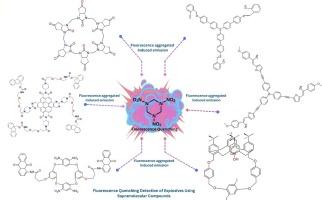Supramolecular luminescent sensors for explosive detection: Current trends and future directions
IF 4.9
2区 化学
Q1 CHEMISTRY, ANALYTICAL
引用次数: 0
Abstract
The imperative of global security amidst persistent threats of terrorism, organized crimes, and accidental events underscores the critical role of explosive detection in safeguarding public safety. While effective, traditional detection methods are often time- and resource-intensive and may not always be suitable for on-site applications in specific scenarios. Consequently, there has been a concerted research effort to develop fluorescent materials with diverse sensing mechanisms to achieve heightened sensitivity, selectivity, and rapid response times in explosive detection. This review explores the exploration of supramolecular systems, including cucurbit[n]uril, pillar [n]arenes, cyclodextrin, calixarenes, electron-rich supramolecules, and related complexes, designed to enhance the efficiency of explosive detection. Recent advancements and emerging technologies in this field are discussed in the review, intending to stimulate further inquiry and innovation in synthesizing and applying supramolecular complexes for explosive detection, addressing the urgent demand for heightened security measures.

用于爆炸物检测的超分子发光传感器:当前趋势和未来方向
在恐怖主义、有组织犯罪和意外事件的持续威胁下,全球安全势在必行,这凸显了爆炸物检测在保障公共安全方面的关键作用。传统的检测方法虽然有效,但往往需要耗费大量的时间和资源,而且不一定适合特定场景下的现场应用。因此,人们一直在努力研究开发具有不同传感机制的荧光材料,以提高爆炸物检测的灵敏度、选择性和快速响应时间。本综述探讨了对超分子系统的探索,包括葫芦[n]脲、柱[n]烯、环糊精、钙烯、富电子超分子和相关复合物,旨在提高爆炸物检测的效率。综述讨论了这一领域的最新进展和新兴技术,旨在激励人们进一步探索和创新,合成和应用超分子复合物进行爆炸物检测,以满足加强安全措施的迫切需求。
本文章由计算机程序翻译,如有差异,请以英文原文为准。
求助全文
约1分钟内获得全文
求助全文
来源期刊

Microchemical Journal
化学-分析化学
CiteScore
8.70
自引率
8.30%
发文量
1131
审稿时长
1.9 months
期刊介绍:
The Microchemical Journal is a peer reviewed journal devoted to all aspects and phases of analytical chemistry and chemical analysis. The Microchemical Journal publishes articles which are at the forefront of modern analytical chemistry and cover innovations in the techniques to the finest possible limits. This includes fundamental aspects, instrumentation, new developments, innovative and novel methods and applications including environmental and clinical field.
Traditional classical analytical methods such as spectrophotometry and titrimetry as well as established instrumentation methods such as flame and graphite furnace atomic absorption spectrometry, gas chromatography, and modified glassy or carbon electrode electrochemical methods will be considered, provided they show significant improvements and novelty compared to the established methods.
 求助内容:
求助内容: 应助结果提醒方式:
应助结果提醒方式:


